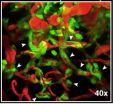WSU researcher sees survival story in Antarctic fly's small genome
One tough midge
2014-08-12
(Press-News.org) PULLMAN, Wash.—Few animals can boast of being as tough as the Antarctic midge. Its larvae develop over not one but two Antarctic winters, losing nearly half their body mass each time. It endures high winds, salt, and intense ultraviolet radiation. As an adult, the midge gets by without wings and lives for only a week or so before starting its life cycle all over again.
And as Joanna Kelley has learned, it does this with the smallest insect genome sequenced so far.
"It's tiny," said Kelley, a Washington State University assistant professor, who recently sequenced and analyzed the genome with colleagues around the U.S. "That was a huge surprise. I was very impressed."
Writing in the online journal Nature Communications, Kelley and her fellow researchers say the midge genome has only 99 million base pairs, the building blocks of their DNA. By comparison, the human genome has 3.2 billion base pairs.
"We suspect that it's somehow an adaptation to the extreme environment," says Kelley. "And it opens up a lot of interesting hypotheses to hopefully test by sequencing additional Antarctic organisms or sub-Antarctic organisms, because there are other flies, or Diptera, on some of the sub-Antarctic islands. We're really interested to see whether or not they have similar genomes."
Living on rock outcrops on the Antarctic Peninsula, the midge is the only insect and fully terrestrial animal endemic to the continent. In looking at its genes and comparing them with their known functions in other animals, Kelley and her colleagues found an abundance of genes geared towards regulation and developmental processes.
On the other hand, it has few odorant receptors. This could be because it rarely ventures far, having no wings, and doesn't need to detect things much further than it can walk.
Compared to other insects, like mosquitoes and other flies, the midge has an extremely economical genome, with very few repeated genetic sequences and shorter stretches of DNA, called introns, separating coding regions of the genome.
Overall, the genome, said Kelley, "opens up a lot of questions for me about genome evolution and I'm looking at other related organisms to try and get at that question. What allows or inhibits a genome from being very large or small and what are the consequences of that?
"It's a pretty exciting fly."
INFORMATION:
Kelley's colleagues on the genome project are affiliated with The Ohio State University, Stanford University, the Institut des Sciences de l'Evolution in France, the University of Florida, Texas A&M University and Miami University.
ELSE PRESS RELEASES FROM THIS DATE:
Transgender relationships undermined by stigma
2014-08-12
PROVIDENCE, R.I. — Researchers who looked at the impact of discrimination, poverty and stigma on the mental health and relationship quality of transgender women and their male romantic partners found that social and economic marginalization not only takes a psychological toll on each person individually but also appears to undermine them as a couple.
It is difficult to be a transgender woman in the United States. Prior research has shown that they generally face high risks of depression, financial hardship, and discrimination, said study lead author Kristi Gamarel, a ...
Majority of Quebec children placed in out-of-home care are reunited with their family
2014-08-12
The majority of children in Quebec's youth protection system who are placed in out-of-home care (family foster care, or in a group or rehabilitation centre) are reunited with their "natural" families within 6 months, according to a study led by Professor Tonino Esposito of University of Montreal's School of Social Work. However, younger children, specifically those aged 2 to 5 years old at initial placement, have the lowest likelihood of returning to live with their natural families over time. "All placed children, irrespective of age, are less likely to return to live ...
Scared of crime? Good.
2014-08-12
EAST LANSING, Mich. -- In the past half-century, fear of crime in the United States has fueled "white flight" from big cities, become known as a quality of life issue and prompted scholars and law enforcement experts to address ways of reducing this fear.
But a study by a Michigan State University criminologist challenges this longstanding theory by arguing that a healthy fear of crime is, in fact, a good thing.
The study, published online in the journal Justice Quarterly, suggests adolescents who are more fearful of crime are less apt to become victims and offenders ...
ADHD, substance abuse and conduct disorder develop from the same neurocognitive deficits
2014-08-12
This news release is available in French. Researchers at the University of Montreal and CHU Sainte-Justine Research Centre have traced the origins of ADHD, substance abuse and conduct disorder, and found that they develop from the same neurocognitive deficits, which in turn explains why they often occur together. "Psychopathology exists on multiple continua of brain function. Some of these dimensions contribute to a multitude of problems, others contribute to specific problems. Together, they explain patterns of comorbidity such as why ADHD and conduct problems co-occur ...
Loss of eastern hemlock affects peak flows after extreme storm events
2014-08-12
The loss of eastern hemlock could affect water yield and storm flow from forest watersheds in the southern Appalachians, according to a new study by U.S. Forest Service scientists at the Coweeta Hydrologic Laboratory (Coweeta) located in Otto, North Carolina. The article was just published online in the journal Ecohydrology.
"Eastern hemlock trees have died throughout much of their range due to the hemlock woolly adelgid, an exotic invasive insect," said Steven Brantley, a post-doctoral researcher at Coweeta and lead author of the paper. "Though this insect has decimated ...
Graphene-based planar micro-supercapacitors for on-chip energy storage
2014-08-12
The rapid development of miniaturized portable electronic devices, such as micro-electromechanical systems, microrobots and implantable medical devices, has stimulated intense demand for micro-scale power sources. Although miniaturized micro-batteries that store energy by redox reactions provide the most frequently used micro-power source for current portable electronics on chip, their limited lifetime (hundreds or thousands of cycles) and low power density rule out applications that require high power over a short timeframe.
Micro-supercapacitors (MSCs) with a short ...
Researchers prove stability of wonder material silicene
2014-08-12
An international team of researchers has taken a significant step towards understanding the fundamental properties of the two-dimensional material silicene by showing that it can remain stable in the presence of oxygen.
In a study published today, 12 August, in IOP Publishing's journal 2D Materials, the researchers have shown that thick, multilayers of silicene can be isolated from its parent material silicon and remain intact when exposed to air for at least 24 hours.
It is the first time that such a feat has been achieved and will allow scientists to further probe ...
Prognosis of pneumonia: value of respiratory rate often overlooked
2014-08-12
Pneumonia – a severe lung infection – is the most common disease calling for hospital admission. More than one out of ten pneumonia patients die of the disease. Thus it is vital to accurately predict and closely monitor the clinical course. Here, measuring the respiratory rate – the number of breaths a person takes in a minute – provides valuable information. However, far too little use is still being made of this vital sign in clinical practice, as Richard Strauß and co-authors conclude in their recent study in Deutsches Ärzteblatt (Dtsch Arztebl Int 2014; 111: 503).
The ...
Hijacking the brain's blood supply: tumor discovery could aid treatment
2014-08-12
ANN ARBOR, Mich. — Dangerous brain tumors hijack the brain's existing blood supply throughout their progression, by growing only within narrow potential spaces between and along the brain's thousands of small blood vessels, new research shows for the first time.
The findings contradict the concept that brain tumors need to grow their own blood vessels to keep themselves growing – and help explain why drugs that aim to stop growth of the new blood vessels have failed in clinical trials to extend the lives of patients with the worst brain tumors.
In fact, trying to ...
Lead released from African cookware contaminates food
2014-08-12
San Francisco and Yaoundé – Lead levels in foods prepared in aluminum pots from Cameroon exceed U.S. guidelines for lead consumption according to a new study published this month. A typical serving contains almost 200 times more lead than California's Maximum Allowable Dose Level (MADL) of 0.5 micrograms per day.
Researchers at Ashland University and Occupational Knowledge International tested 29 samples of aluminum cookware made in Cameroon and found almost all had considerable lead content. This cookware is common throughout Africa and Asia and is made from recycled ...
LAST 30 PRESS RELEASES:
Interaction of climate change and human activity and its impact on plant diversity in Qinghai-Tibet plateau
From addressing uncertainty to national strategy: an interpretation of Professor Lim Siong Guan’s views
Clinical trials on AI language model use in digestive healthcare
Scientists improve robotic visual–inertial trajectory localization accuracy using cross-modal interaction and selection techniques
Correlation between cancer cachexia and immune-related adverse events in HCC
Human adipose tissue: a new source for functional organoids
Metro lines double as freight highways during off-peak hours, Beijing study shows
Biomedical functions and applications of nanomaterials in tumor diagnosis and treatment: perspectives from ophthalmic oncology
3D imaging unveils how passivation improves perovskite solar cell performance
Enriching framework Al sites in 8-membered rings of Cu-SSZ-39 zeolite to enhance low-temperature ammonia selective catalytic reduction performance
AI-powered RNA drug development: a new frontier in therapeutics
Decoupling the HOR enhancement on PtRu: Dynamically matching interfacial water to reaction coordinates
Sulfur isn’t poisonous when it synergistically acts with phosphine in olefins hydroformylation
URI researchers uncover molecular mechanisms behind speciation in corals
Chitin based carbon aerogel offers a cleaner way to store thermal energy
Tracing hidden sources of nitrate pollution in rapidly changing rural urban landscapes
Viruses on plastic pollution may quietly accelerate the spread of antibiotic resistance
Three UH Rainbow Babies & Children’s faculty elected to prestigious American Pediatric Society
Tunnel resilience models unveiled to aid post-earthquake recovery
Satellite communication systems: the future of 5G/6G connectivity
Space computing power networks: a new frontier for satellite technologies
Experiments advance potential of protein that makes hydrogen sulfide as a therapeutic target for Alzheimer’s disease
Examining private equity’s role in fertility care
Current Molecular Pharmacology achieves a landmark: real-time CiteScore advances to 7.2
Skeletal muscle epigenetic clocks developed using postmortem tissue from an Asian population
Estimating unemployment rates with social media data
Climate policies can backfire by eroding “green” values, study finds
Too much screen time too soon? A*STAR study links infant screen exposure to brain changes and teen anxiety
Global psychiatry mourns Professor Dan Stein, visionary who transformed mental health science across Africa and beyond
KIST develops eco-friendly palladium recovery technology to safeguard resource security
[Press-News.org] WSU researcher sees survival story in Antarctic fly's small genomeOne tough midge





